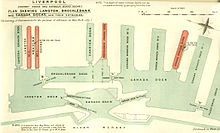
Summary
Langton Dock is a dock on the River Mersey, England, and part of the Port of Liverpool. It is situated in the northern dock system in Bootle, connected to Alexandra Dock to the north and Brocklebank Dock to the south. Langton Dock locks provide a working connection to the river; one of the two remaining operational river entrances in the northern dock system.
| Langton Dock | |
|---|---|
 The lock of the Langton River Entrance | |
| Location | |
| Location | Bootle, Merseyside, United Kingdom |
| Coordinates | 53°26′37″N 3°00′33″W / 53.4436°N 3.0092°W |
| OS grid | SJ330945 |
| Details | |
| Owner | The Peel Group |
| Operator | Mersey Docks and Harbour Company |
| Opened | 1881[1] |
| Type | Wet dock |
| Joins | |

History edit
The dock was built by George Fosbery Lyster,[2] and officially opened along with Alexandra Dock in 1881.[3] The dock had been partially in use since 1879.[1] It was named after William Langton, a member of the dock committee, and a former Chairman of the Bank of Liverpool.[1] As originally built, Langton Dock consisted of a basin adjoining the river wall, with a branch dock and two graving docks to the east.[1] Access from the river was initially via Canada Basin.[1]
The dock was intended for very large vessels of the time and was used for trading in the Mediterranean.[3] Shipping companies, which used the dock, included Ellerman Lines and John Glynn.[3]
Subsequent modifications were made to Langton Dock and the surrounding basins during the twentieth century to improve access. Between 1949-62, this included the construction of the Langton River Entrance,[2] which was eventually opened by Queen Elizabeth II on 14 December 1962, after being delayed by a series of problems.[1]
The branch dock and graving docks were filled in, providing parking spaces for vehicles using the former Brocklebank Dock ferry terminal to Belfast, Northern Ireland. On the closure of the Pier Head's Princes Landing Stage, the remaining dock basin was occasionally used as terminal for the start of cruises, accommodating cruise ships. However, since the opening of the Liverpool cruise liner terminal in 2013, Langton Dock has ceased to berth cruise liners.[4]
The Langton Dock Pump House is on the Victorian Society's list of endangered buildings.[5] The Pump House provided hydraulic power for the dock complex, and maintained water levels within the docks.
In common with some other Liverpool docks, Langton provided dockside accommodation for employees. An octagonal compound, containing seven separate houses built around a central courtyard, was built close to the narrower lock from Canada Basin into Langton Dock. Named Langton Buildings, it enabled key staff to be on hand at any time. There was also a staff flat upstairs in the Pump House.
References edit
- ^ a b c d e f "Langton Dock". Liverpool History Online. Archived from the original on 16 January 2009. Retrieved 5 July 2008.
- ^ a b Pollard & Pevsner 2006, p. 277
- ^ a b c McCarron & Jarvis 1992, pp. 61–62
- ^ "Mersey base for luxury liner". Liverpool Daily Post. 7 July 2007. Archived from the original on 28 August 2008. Retrieved 5 July 2008.
- ^ "Langton Dock Pumphouse, Bootle, Merseyside". The Victorian Society. Archived from the original on 6 November 2012. Retrieved 27 October 2012.
Sources edit
Further reading edit
External links edit
- "Liverpool North Docks diagram". Archived from the original on 6 January 2009.


